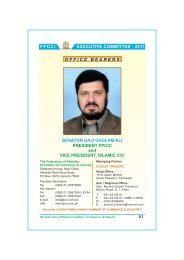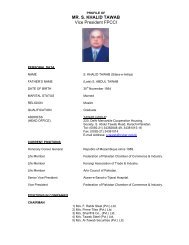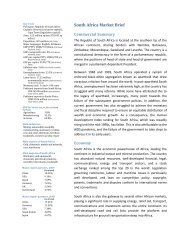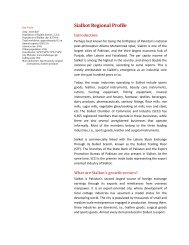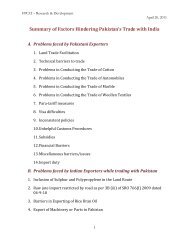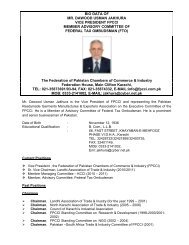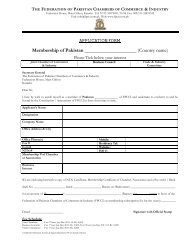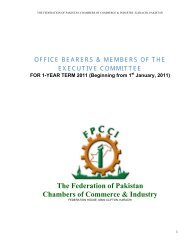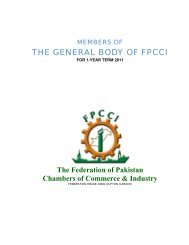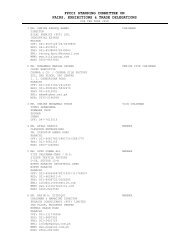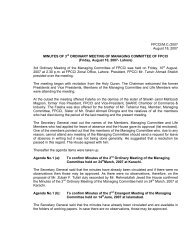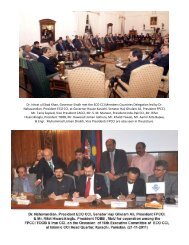Association of Southeast Asian Nations (ASEAN)
Association of Southeast Asian Nations (ASEAN)
Association of Southeast Asian Nations (ASEAN)
- No tags were found...
You also want an ePaper? Increase the reach of your titles
YUMPU automatically turns print PDFs into web optimized ePapers that Google loves.
<strong>Association</strong> <strong>of</strong> <strong>Southeast</strong> <strong>Asian</strong> <strong>Nations</strong> (<strong>ASEAN</strong>)OverviewThe <strong>Association</strong> <strong>of</strong> <strong>Southeast</strong> <strong>Asian</strong> <strong>Nations</strong> is a geo-political and economicorganization <strong>of</strong> 10 countries located in <strong>Southeast</strong> Asia, which was formed onAugust 8, 1967 by Indonesia, Malaysia, the Philippines, Singapore and Thailand.Its aims include the acceleration <strong>of</strong> economic growth, social progress, culturaldevelopment among its members, and the promotion <strong>of</strong> regional peace.Having a population <strong>of</strong> 1077.5 million, <strong>ASEAN</strong> has the GDP <strong>of</strong> US $ 1094.6billion in year <strong>of</strong> 2006 with a share <strong>of</strong> US $ 1286 billion in world’ total tradewhich was 6.1% share <strong>of</strong> the total world trade. Share <strong>of</strong> imports <strong>of</strong> all <strong>ASEAN</strong>member countries is US $ 613 billion witch accounts for 5.7% <strong>of</strong> world import; inexports there is a positive Balance <strong>of</strong> Trade exist having a total export volume inUS $ 673.4 billion which is 6.5% share <strong>of</strong> the world total exports.Among all the eleven nations <strong>of</strong> <strong>ASEAN</strong> the economy <strong>of</strong> Indonesia showsimmense growth and have the GDP <strong>of</strong> US $ 315.4 billion in 2006 which was28.8% share <strong>of</strong> among the <strong>ASEAN</strong> member nations while GDP for Pakistan isabout $133.9 billion which is only 5% share among the <strong>ASEAN</strong> membercountries. GDP per capita <strong>of</strong> Singapore was highest $28940 followed by Malaysia$ 5457 and Thailand $ 2805. Total trade <strong>of</strong> Singapore was also highest in 2006 $430.6 billion, followed by Malaysia $ 255.6 billion and Thailand $ 228.3 billionbeside that Cambodia has the least trade volume <strong>of</strong> $ 6.8 billion.INTRA –<strong>ASEAN</strong> TRADE<strong>ASEAN</strong> total intra-regional trade share is 24.5 comparing 75.5 with the rest <strong>of</strong> theworld. In 2006 the intra-regional trade import share was 24.2% while intraregionaltrade export share was 24.8%.Intra-regional trade import in year 2005 was $ 243 billion, comparing with theintra-regional trade import for year 2006 $ 306 billion showing an increase about25.9%.
<strong>ASEAN</strong> Economic Community<strong>ASEAN</strong> has emphasized regional cooperation in the “three pillars” <strong>of</strong> security,socio-cultural and economic integration. The regional grouping has made themost progress in economic integration, aiming to create an <strong>ASEAN</strong> EconomicCommunity (AEC) by 2015. The AEC would have a combined population <strong>of</strong> over566 million and a GDP exceeding US$ 1.173 trillion.<strong>ASEAN</strong> Free Trade AreaThe foundation <strong>of</strong> the AEC is the <strong>ASEAN</strong> Free Trade Area (AFTA), a commonexternal preferential tariff scheme to promote the free flow <strong>of</strong> goods within<strong>ASEAN</strong>. The <strong>ASEAN</strong> Free Trade Area (AFTA) is an agreement by the membernations <strong>of</strong> <strong>ASEAN</strong> concerning local manufacturing in all <strong>ASEAN</strong> countries. TheAFTA agreement was signed on January 28, 1992 in Singapore. When the AFTAagreement was originally signed, <strong>ASEAN</strong> had six members, namely, Brunei,Indonesia, Malaysia, the Philippines, Singapore and Thailand. Vietnam joined in1995, Laos and Myanmar in 1997, and Cambodia in 1999. The latecomers havenot fully met the AFTA's obligations, but they are <strong>of</strong>ficially considered part <strong>of</strong> theAFTA as they were required to sign the agreement upon entry into <strong>ASEAN</strong>, andwere given longer time frames in which to meet AFTA's tariff reductionobligations.<strong>ASEAN</strong> Investment Area (AIA)The AIA will encourage the free flow <strong>of</strong> investment within <strong>ASEAN</strong>. The mainprinciples <strong>of</strong> the AIA are as follows:• All industries are to be opened up for investment, with exclusions to bephased out according to schedules• National treatment is granted immediately to <strong>ASEAN</strong> investors with fewexclusions• Elimination <strong>of</strong> investment impediments• Streamlining <strong>of</strong> investment process and procedures• Enhancing transparency• Undertaking investment facilitation measuresFull realization <strong>of</strong> the AIA with the removal <strong>of</strong> temporary exclusion lists inmanufacturing agriculture, fisheries, forestry and mining is scheduled by 2010
for most <strong>ASEAN</strong> members and by 2015 for the CLMV countries (Cambodia, LaoPDR, Myanmar, and Viet Nam).<strong>ASEAN</strong> Framework Agreement on Trade in ServicesAn <strong>ASEAN</strong> Framework Agreement on Trade in Services was adopted at the<strong>ASEAN</strong> Summit in Bangkok in December 1995. Under the agreement, <strong>ASEAN</strong>members are negotiating intra-regional services liberalization in several sectors,including air transport, business services, construction, financial services,maritime transport, telecommunications and tourism. Although some sectorshave liberalized faster, such as air transport, other sectors remain subject tocontinued negotiation. Efforts to expand the scope <strong>of</strong> the Framework Agreementalso remain subject to continued negotiations.



